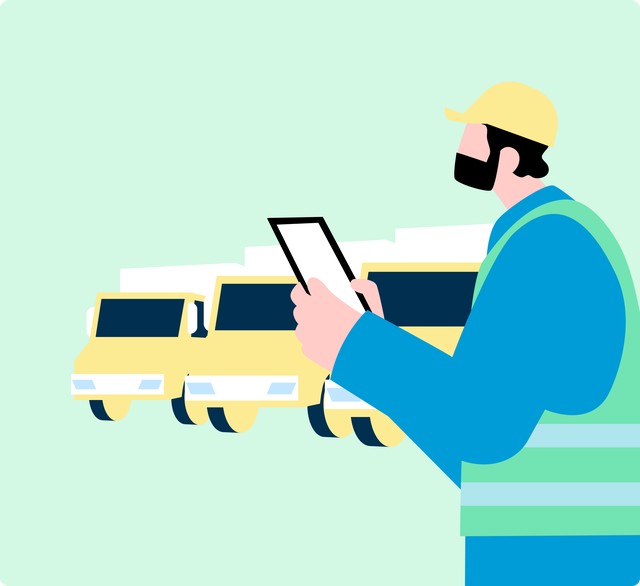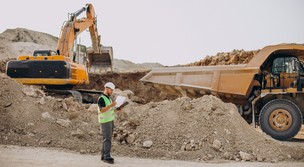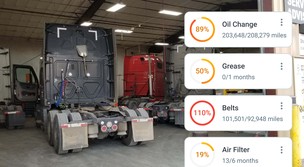Fleet management comes with a headache the size of a dump truck. And let’s be real, that isn’t on anyone’s job description. What’s causing the worst pain? What painkillers do you get?
In this article, we break down the biggest fleet management challenges, why they suck are not cool, and how the experts solve them.
But first, a quick intro. We’re the team behind Fleet Chaser, a fleet management software built for construction and service industries. We talk to fleet operators daily, hear their struggles firsthand, and know what issues hit hardest.
We’d love to share what we know.
Five key challenges faced by fleet managers in 2025
We dug into the latest reports and expert articles, and talked to our own customers to pinpoint the biggest fleet management challenges.
Here’s what’s giving fleet teams the most trouble:
- Rising costs and budget pressures
- Lack of a single view of fleet ops
- Fleet safety and driver behavior
- Meeting customer demand
- Fraud and cargo theft
Laying out the most pressing challenges of fleet management
Below, we break down why these challenges are so frustrating, how they impact fleets, and what you can actually do about each one.
Challenge 1. Rising costs and budget pressures
Keeping your budget in check? Damn near impossible. 80% of fleet costs aren’t fixed. They depend on fuel prices, repairs, labor, and market conditions. Maintenance alone is up 10%+.
And just when you think you've got a handle on spending, a surprise breakdown or price hike blows your budget:
“Rising costs have made it extremely difficult to predict cost outcomes throughout 2024. [...] Any disruption in world events or business environment changes can have a huge impact on the budget,” says Joe Schmoeckel, a fleet manager at the pharmaceutical company Lundbeck.
In fact, rising costs are the most urgent challenge for 77% of fleet professionals — up from 44% in 2021. Cost concerns grow across fleets of all sizes and industries.
What causes the challenge
We’ve got to thank cost trends like inflation that makes everything fleet-related costs more, fleet discounts and incentives disappearing, and even hidden costs like tolls, taxes, and disposal fees increasing.
What fleets can do
Of course, you can’t control inflation or interest rates, but you can focus on specific areas to cut fuel and maintenance expenses.
For Lisa Kneggs, a fleet manager at Farmer Brothers, these areas are utilization (tracking how long a vehicle is actually in motion) and cost allocation. For example, instead of annual reports, Kneggs looks at weekly data for more detailed metrics:
“It really helps a lot because we know down to the dollar what it’s costing us per hour to utilize that truck or not utilize it,” Kneggs says.
If you use telematics devices (that collect key data from your fleet vehicles) and fleet software (that makes sense of this data for you), your fleet will provide you with a fantastic amount of data to highlight your areas of improvement.
Such software helps fleets across industries cut fuel consumption, accident, and labor costs:

2025 Fleet Technology Trends Report highlights how fleet management software helps cut costs across industries.
Preventative maintenance is another cost-saving thing that telematics + fleet software lets you do. Instead of scrambling for emergency repairs, you fix issues early with proactive maintenance.
The repairs are the same, the difference is when and why. Are you dealing with a breakdown after a missed job, a pricey tow, or an unexpected downtime? Or do you handle maintenance before failure happens with automated alerts and real-time vehicle health insights?
For Jeff, a fleet manager at Blythe, it’s the latter. He catches issues early using Fleet Chaser’s fault alerts and weekly vehicle usage reports. Tracking diagnostic trends over time helps him stay proactive.
“The log, tracker and alerts ensure that our vehicles are always on the ready,” says Jeff.

With Fleet Chaser, you can create (and schedule) reports to monitor vehicle use, prevent overuse, and reduce wear and tear on your fleet.
Challenge 2. Meeting customer demand amid high competitive pressure
Customers expect faster service, real-time updates, and full transparency. But keeping up with this demand is harder than ever. 51% of fleet managers rank it a top challenge in 2025 — up from 40% in 2021.
What causes the challenge
Services like Uber Eats and Amazon have made fast, trackable shipping the new normal. Terry Dell of Verizon Connect confirms that modern customers expect more visibility and real-time updates on their service deliveries:
“We can think of it like — I can watch my pizza being delivered to my home in real-time, but I don't really know when you're going to be here to service my HVAC system.”
Smaller businesses feel pressure to keep up with these expectations.
You might already be working hard to provide fast, transparent service, but things like traffic jams and sudden weather changes can wreck even the best plans. One minute, your vehicles are on schedule. No wait, they're stuck in a sea of brake lights, rain pouring down, deadlines slipping away, and money draining with every minute.

Fleet Chaser provides more than just vehicle locations. It shows road conditions and weather, helping you assign tasks smarter and faster.
Why this matters
Customers can quickly compare options and switch to a provider that offers better speed and transparency. If you’re not meeting their expectations, your competitors will. Competitive pressure is rising: 32% of fleets report facing more competition, up from 28% last year.
What fleets can do
Share live tracking links and provide accurate arrival windows to improve service transparency and provide an Uber-like experience. 51% of fleet pros said GPS fleet tracking helps them meet customer demands and achieve these key goals:
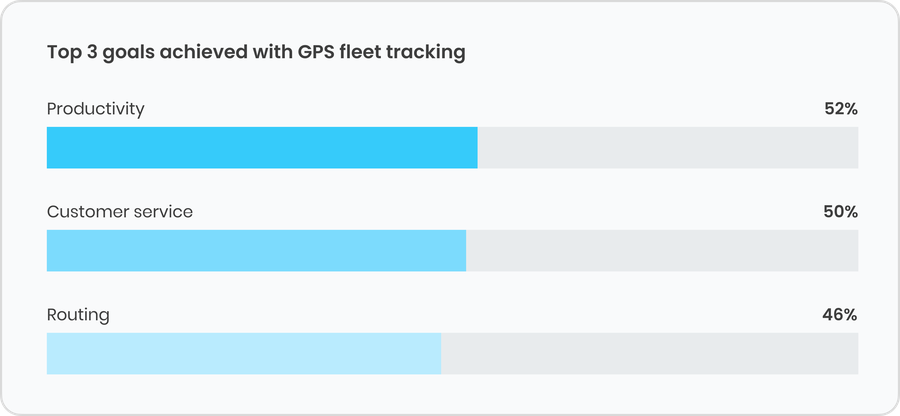
2025 Fleet Technology Trends Report highlights top three goals fleet companies achieve with GPS tracking
Case in point: Fleet manager Vlad at a landscaping company Landmark Materials makes sure their dump trucks are getting to the sites on time with Fleet Chaser. They check in on the drivers, notify clients regarding arrival times, and accurately charge them. Plus, a verified vehicle location history helps them address false claims and service disputes.
“Fleet Chaser continues to save us a TON of money and allows us to give our clients better timing and a better product,” shares Vlad.
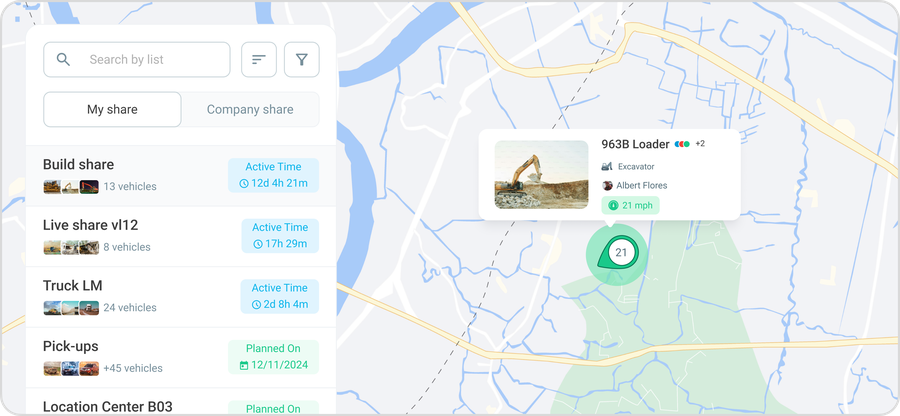
Share live vehicle tracking links with your customers with Fleet Chaser. No need for calls.
Overall, a fleet management system keeps all your work orders in one place. Dispatchers can assign and track jobs in real-time. While drivers get instant updates on new assignments or changes.
The result? More jobs completed, better service, and happier customers.
Challenge 3. Fleet safety and driver behavior
Fleet management isn’t just about vehicles. It’s about the people behind the wheel. And when drivers aren’t prioritized, safety takes a hit. New data shows that 70% of fleet businesses worldwide have been affected by distracted driving incidents.
What causes the challenge
Unsafe driving habits like speeding, harsh braking, fatigue, and distractions put fleets at risk. The Global Distracted Driving Report found that 400+ fleet professionals rank phone use, eating/drinking, and fatigue as the top three causes of driver distractions.
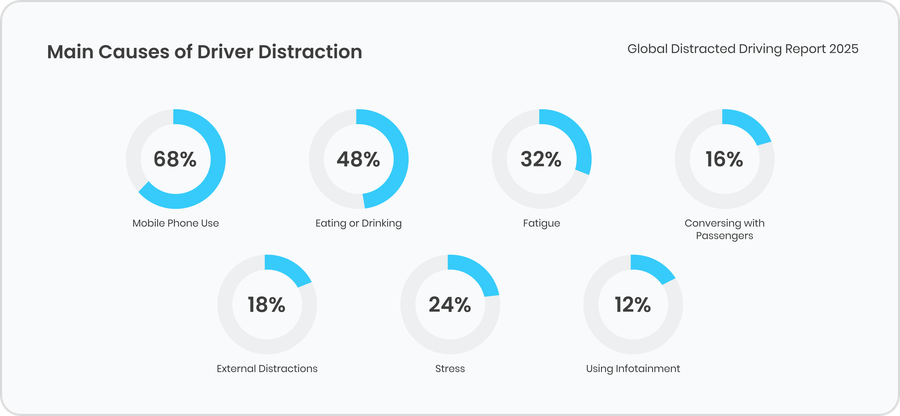
2025 Global Distracted Driving Report reveals the main causes of driver distractions
The problems get worse when there’s no safety monitoring. No telematics, no driver training, and no accountability. Risky behavior is harder to track and prevent.
Why it matters
Distracted driving isn’t just a safety issue—it’s a life-or-death risk for drivers, passengers, and everyone on the road. Truck drivers, in particular, face greater dangers than those in passenger cars.
But the impact doesn’t stop there. Distracted driving also takes a heavy toll on businesses. 1 in 2 fleet professionals report direct financial losses due to accidents caused by distraction:
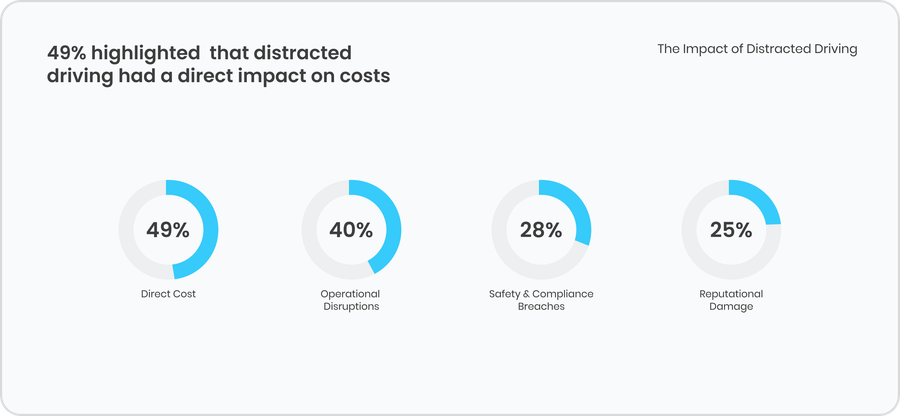
2025 Global Distracted Driving Report reveals the commercial impact of distracted driving
What fleets can do
The key to improving fleet safety is pairing technology with change management. Here’s some tips.
1️⃣ Use telematics and dashcams to spot risks and prevent false claims
Dual dashcams (road + in-cab) and telematics help monitor risky driving, track vehicle health in real-time, and provide accident evidence. You can set alerts to wake drowsy drivers, while video footage clarifies who’s at fault in a crash, if it happens.

A dual dash camera records the in and out of the vehicle
Expert tip: Matthew Betz (former DTE Energy fleet manager) recommends analyzing telematics data by region and department to pinpoint trends, creating custom reports. For example, if one area has higher accident rates, it may signal dangerous road conditions. Fleet managers can then adjust routes or increase vehicle maintenance schedules to prevent wear and tear.
75% of fleets using telematics + dashcams report improved driver safety. Meanwhile, 47% fleets have seen fewer accidents, and 61% — better awareness of distracted driving.
One of the biggest benefits, though? Protecting fleets from false accident claims. This is something we've seen happen frequently with our own clients. For example, Mark from Value Waste avoided three accident claims thanks to GPS tracking and dashcam footage that proved his drivers weren’t at fault. “Right there, [avoiding] the three accidents saved me tons of money,” he shared.
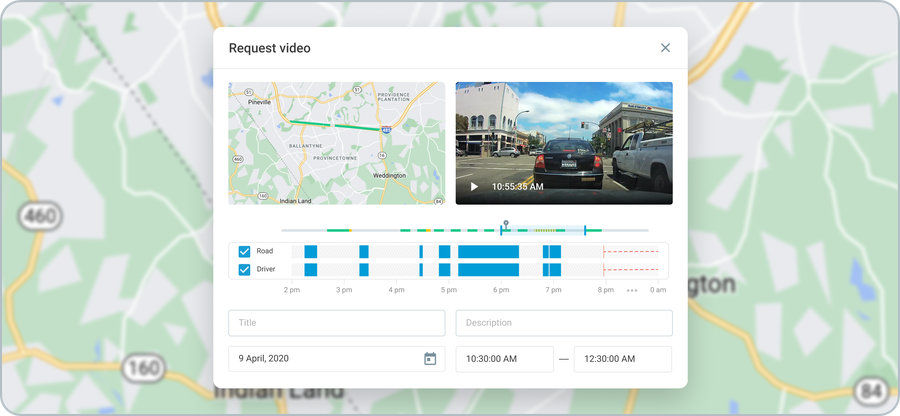
Fleet Chaser’s telematics dash cams provide live footage of both the driver and the road. Safety and fleet managers and company owners can check recordings anytime.
2️⃣ Get driver buy-in
The best safety tech fails without driver support. If they see it as "Big Brother," they’ll resist. Terry Dell of Verizon Connect says change must be “leadership-born but employee-driven”:
“Work with your drivers so that they get engaged, adopt it [the tech], and won’t feel like it’s 'Big Brother' watching. Instead, they should see it as an investment in their safety. Then, champions will emerge throughout the organization to help drive that culture.”
Here’s how to make it stick:
- Let experienced drivers mentor new hires
- Reward safe driving with scorecards and incentives
- Enforce rest policies to prevent fatigue-related crashes
Challenge 4. Lack of a single view of fleet operations
Lack of visibility is another root for pesky fleet management challenges. Without real-time look into your vehicle’s location and performance, you’re left wondering about your fleet's operational efficiency. Are drivers taking the best routes? Who’s the closest to handle the job? Is poor fuel efficiency driving up costs? How long each piece of equipment is running — what should you bill?
You get the point.
What causes the challenge
Many fleets have different data sources and points of communication. 1 in 2 fleet leaders uses more than 10 different individual tools to manage their fleet, while 1 in 5 still uses pen and paper. They get buried in scattered data.
Why it matters
When data is scattered and overwhelming, important warnings get missed. Too much unorganized data = chaos and liability risks.
“One of my biggest fears is having too much data, and it’s paralyzing, honestly, and I’m afraid of having data that we didn’t notice and then having a liability because of that data,” says Jim Petrillo, Fleet Manager and Treasury Services, Fujifilm.
What fleets can do
Build dashboards that visualize key fleet data collected by your telematics devices. For example, this is the dashboard in Fleet Chaser. It provides all the needed fleet real-time data in an intuitive form, without making you and your team feel overwhelmed.

Fleet Chaser’s customizable dashboards lets you see only what you need and hide the rest. From mechanics to dispatchers and fleet managers, everyone can customize the dashboard to their needs.
Also, if you're considering fleet management software, make sure it comes with a mobile app.
Take Fleet Chaser’s mobile app (yes, it is that convenient 😄) — it gives you real-time data on your entire team, not just your equipment, and lets you communicate within one tool only.
Challenge 5. Fraud and cargo theft
1 in 3 fleet professionals list theft or fraud as a top fleet industry concern. An example is when workers use company-owned equipment for personal side jobs, like mowing non-client yards (this actually happened to one of our customers).
What causes the challenge
- Lack of oversight: Without proper tracking, unauthorized vehicle use and fuel consumption fraud go unnoticed.
- Fuel card misuse: No restrictions or monitoring lead to employees refueling personal vehicles on company accounts.
- No asset tracking: Cargo and equipment left unmonitored are easy targets for theft or misuse.
Why it matters
Lost cargo and fraud mean insurance claims, wasted budget, and delays. Enterprise fleets estimate a 19% annual loss due to theft and fraud, while smaller fleets report 16% annual loss.
Case in point: Billy, a manager at a landscaping company Lake Norman Turf, Inc. found his employees sneaking off to mow non-client yards using company equipment.
Just imagine: if one mower costs $50/hour to operate and an employee misuses it for 5 hours a week, that’s $13,000+ in losses per year on just one piece of equipment. Multiply that by multiple employees, and, well, you get the idea.
What fleets can do
Vigilance and technology are your best defense against fraud and theft. Some tips to consider here:
✔ Monitor fuel card use to flag suspicious transactions. Watch for these fraud red flags in fuel reports:
- Frequent fill-ups: Multiple stops in a short time could mean theft.
- Mismatch in fuel consumption: If a vehicle averages 8 MPG but logs a $300 fuel bill for 100 miles driven, investigate immediately.
- Compare receipts with logs: Check statements against actual receipts to spot unauthorized purchases.
✔ Install GPS and geofencing on high-value cargo. You’ll get instant alerts if a vehicle or asset moves outside an approved area. This is one of the most loved features by Fleet Chaser users. It lets you know when your vehicles arrived or left a job site, how long they spent there and whether they were driving, idling, or chilling at a gas station.

Geofencing in Fleet Chaser provides precise reports that show how long your team spends on the job.
Are these fleet management problems bugging you, too?
While fleet technology won’t magically fix all fleet management challenges (no tool does), it sure helps smooth out the chaos.
And it’s no surprise that for five years straight, Verizon’s Fleet Technology Trends Survey has found that 80%+ of fleet professionals rely on some form of technology — whether it’s telematics, dash cams, or fleet management software, overall.
Why? Because it works. Fleets across industries report lower fuel consumption costs, reduced labor expenses, and fewer accidents. And as the saying goes: money saved is money earned.
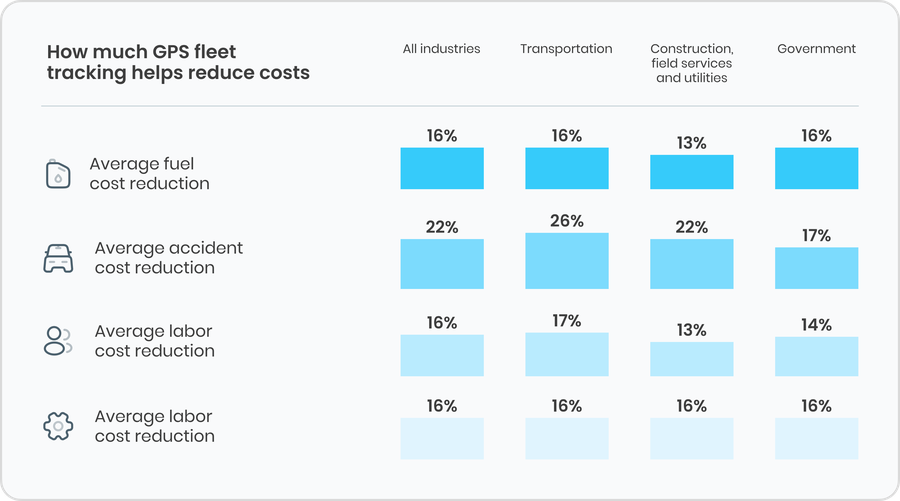
2025 Fleet Technology Trends Report highlights how GPS tracking helps fleets cut operational costs
Squash those fleet management issues with the right tools
You’re reading an article about fleet management challenges, written by a fleet management software company. Of course, the following might sound biased, but Fleet Chaser is a great solution that we suggest trying.
But…we also want to keep it real.
We’re best fit to address the challenges of small and medium construction and service fleets. We know the chaos of job sites, the frustration of tracking expensive machinery, and the challenges of keeping heavy equipment running. So we built Fleet Chaser to solve just that.
Sound like you? Feel free to create a free demo account. No strings attached.
Not you but you’re itching to look into fleet solutions? As you’ll notice, the market is bloated (aren’t they all?). With endless feature-packed options, finding the right fit is freaking hard. Our other article breaks down what features to look for.
At the end of the day, fleet management isn’t just about vehicles. It’s about your team. Whatever solution you choose, we hope you find the best software — your painkiller that makes those fleet management challenges dump-truck headaches disappear.

















